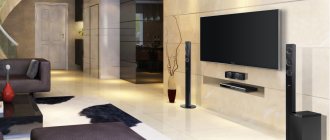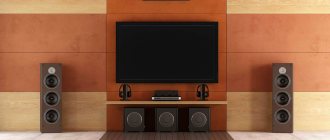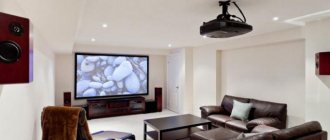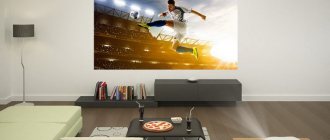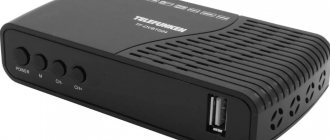Home cinema included.
A classic Hi-Fi home theater is a 5.1 system that uses a pair of front speakers on either side of the screen, one center channel, a pair of rear speakers and a subwoofer. 7.1 or 7.2 systems are also often installed, where side speakers and a second subwoofer are added accordingly. Next come home theater systems 9.1, 11.2, 13.2 and many more options for the placement of acoustics, including even ceiling ones. When building a home theater, you can use any type of speaker systems - floor-standing, bookshelf, suspended, built-in, active and wireless.
The second element of a home theater is a receiver, or as it is now commonly called an AV amplifier, which includes a switch for all digital and analog signal sources, a multi-channel amplifier, surround sound decoders - Dolby Digital, DTS, Dolby Atmos, Auro 3D, DTS X and many others. Equipped with network functions for listening to music from your home network, that is, a computer, server and other network storage, as well as for listening to music from the Internet. It can connect via cable, via Wi-Fi and additionally connect via Bluetooth to mobile devices. It has a large number of settings in manual and automatic mode. They are divided by the number of channels from 5.1 to 16, power and some additional functions. Serious systems use separate components - a processor and an amplifier or several power amplifiers, depending on the number of channels/speaker systems, up to 64!
The next component is the source of audio video content; there may be several of them. Blu-Ray player, media player, game console, satellite receiver, TV set-top box and others.
And of course, you can’t do without a video display device; it can be a TV, preferably a large one, or a projector with a special screen (a white wall or a sheet will not work if you need a high-quality picture).
A simple example of a Dolby Atmos home theater with a projector and screen. You will need a set of 11.2 acoustics, which will have two front speakers, a center channel, two upper front speakers, two rear, two side, two ceiling and two subwoofers, a receiver with the appropriate number of amplification channels, an audio video player and a projector with a screen. The cost of such a home theater can vary from several hundred thousand to several million rubles. But, a cinema can be created for almost any budget, even starting from several tens of thousands - it will, of course, be a simple 5.1 version with small speakers, and if you assemble a home theater using High-End components, then the cost in this case can be completely indecent. And regardless of the price of a home theater set, our salon always has an individual approach to any client, consultation and selection of all equipment, on-site installation and training on system management.
Home theater components
Today, home cinema is a modern system for high-quality reproduction of audio and video signals in a home environment. This is a specific set of AV equipment, where each component plays its role. Only if you have a complete set, will all equipment properly perform its intended functions.
What should a home theater consist of?
- Signal source. It could even be an old VCR, but it is better to use a modern HD player or DVD player. Some users use a high-performance PC for these purposes.
- Amplifier or AV receiver.
- Acoustic system (AS). It all depends on your personal preferences, but experts advise purchasing AC 5.1.
- Display device.
- Set of connecting wires and cables.
The minimum configuration of a modern home theater necessarily consists of the above components. Let's look at each of them in more detail.
How to choose a home theater for your home.
On the one hand, the choice can be very simple; it is to buy a ready-made solution, the so-called one-box home theater. Or take this issue seriously. Determine the room in which the home theater or home cinema will be built; in this case, this is a specially designated room in which it will also be necessary to carry out acoustic treatment. Select acoustic systems appropriate to the size of the room, quantity, power, decide on the type of placement - floor, shelf, built-in, etc. The design of the acoustics will also be important. Select the appropriate receiver or processor with a power amplifier and the necessary sources of audio video content. And decide on what you will watch movies on, TV or a screen with a projector. If you are building a home cinema, definitely a projector! To simplify the choice of equipment for a recreation center, it will be easier for you to contact us at the M-stereo salon, we will help.
The receiver is the brain of any home theater.
The receiver is the ideal home theater. Basically, everything goes into the receiver, and the receiver then outputs those signals to the display and speakers. You can connect a variety of devices to the receiver, such as Fire TV, Roku, cable box, Blu-Ray player, gaming system, etc.
Receivers have a built-in amplifier. An amplifier receives an incoming audio signal, then “amplifies” that signal and outputs both power and sound to the speakers. Individually connected devices will be displayed on the TV/projector and sound will be output through the speaker system.
The receiver is what ties everything together; it is the central control unit for the entire home theater system. They will have various inputs for HDMI, component video, digital optical (TOSLINK), RCA audio, and sometimes digital coaxial audio. Most new devices simply use HDMI and digital optical for inputs, and usually have two HDMI outputs and a varying number of speaker outputs.
Which home theater projector to choose?
There are a huge number of projector options on the market, from tiny pico projectors to huge cinema projectors. And which projector to choose? It is necessary to take into account the size of the room where the cinema will actually be, the desired or possible size of the screen, how dark the room can be, the darker the better. Possible installation location, distance to the screen. And of course the image quality you want to achieve. By adding up all these parameters, you can select the right projector, but in this case it is better to contact specialists, you will significantly save your time.
A few answers to frequently asked questions
How is a home theater different from a TV?
A TV is just a video display device with very mediocre sound due to its physical characteristics.
How is a home theater different from a music center?
The music center includes only two speakers, which will not create the effect of presence when watching movies.
What is the difference between a home theater and a soundbar?
The soundbar only creates a virtual feeling of immersion due to the reflection of sound from the walls; it can only be used if there is absolutely no space for a full-fledged home theater.
What is the difference between a home theater and a Hi-Fi system?
The Hi-Fi system includes only a couple of speakers, which will not allow you to achieve the surround sound effect.
Home theater installation
All equipment is connected to a receiver, which receives and transmits signals. But even with the correct installation of equipment, you may not achieve the desired effect. In order for a home theater to meet all the requirements and contribute to complete immersion in the film, it is necessary to eliminate all possible interference with sound and light:
- Soundproofing. It is necessary to completely seal the window and door openings so that the sound does not disturb the neighbors and does not “escape.”
- Remove unnecessary ones. Indoor plants, furniture and various decorative elements can interfere with the passage of sound waves.
- No extra light. The image may not be clear, and may also lose brightness from otherworldly light sources, so if there are windows in the room, then special filters must be installed on them.
To create a real cinema at home, it is not necessary to purchase expensive equipment and be the owner of a spacious room. Even in a small room you can create a real cinema hall, which is not inferior in its characteristics to a full-fledged cinema. It is enough to choose, arrange and connect all the equipment correctly to plunge into the unreal world of exciting adventures, fantastic fairy tales or crime detectives.
Why do you need a home theater?
The phrase “home cinema” does not surprise anyone today. But only a few people imagine what it is. The most common idea is a large TV, or less often - a bunch of speakers located throughout the room, where the sound comes not only from the TV, but from all sides.
What is a home cinema?
A home theater is a whole system that includes any TV (or projector), 6 speakers (5.1 speaker system), a multi-channel power amplifier (AV receiver), as well as any audio/video source (DVD or Blu-Ray player, HD media player, computer, etc.)
The main part of the home theater is the 5.1 speaker system, which includes: two front speakers, two rear speakers, one center channel and one subwoofer.
Why do you need a home theater?
Today, all the films that we watch from discs or download from the Internet are recorded in multi-channel surround sound format: Dolby Digital or DTS (or in their HD versions). We often watch such films on a regular TV. But not a single TV, no matter how modern it is, is capable of conveying the sound picture exactly as the sound engineer intended it.
For example, in the movie "Avatar" you see Jake on the screen flying on a lizard from left to right above the viewer's head. According to the director, the sound should also move after him. In the movie Godzilla, in one of the scenes the main character runs away from a giant lizard, in the end it turns out that Godzilla is breathing down your neck, that is, the sound of his breathing should come from behind. In the movie True Lies, in the scene where the main character and his partner are dancing tango, the sound of the orchestra rotates after the couple.
Thus, the main goal of a home theater is to create the effect of being at the scene of events, to create a three-dimensional sound picture and to watch a film or music concert exactly as the sound engineer intended it. Only in this case you will be able to get maximum emotions from watching.
Can a home theater be used only for watching movies?
Of course not. It can be used to listen to music concerts. As an example, the last concert of Depeche Mode in Barcelona. When the whole audience sings along with David Gahan, the effect of presence exceeds all expectations!
In addition, the home theater can easily be connected to a computer, game console, or HD media player. You can listen to music from a USB flash drive, external hard drive or iPod/iPhone/iPad. You can also listen to FM or Online radio. If you have satellite or cable TV, you can easily output sound to your home theater.
Is it true that you need a special room for a home theater?
No. A home theater can be placed in absolutely any room: there are speakers of different sizes and different powers. There are speakers that will take up minimal space in the room, or they can be placed under the ceiling. As an option, there is built-in acoustics, which allows you to make the audio system completely invisible, thereby preserving the original interior of the room.
Speaker systems for home cinema are available in various colors: classic - black, brown, as well as yellow, grey, white, red, etc. Thanks to this, the home cinema will easily fit into the interior of any room.
There is also built-in acoustics, which allows you to make the audio system completely invisible, thereby preserving the original interior of the room.
Where is the best place to buy a home theater?
For more than 11 years, we have been working only with leading home theater manufacturers: Focal, Harman/Kardon, Integra, JBL, KEF, Music Hall, NAD, Wharfedale, as well as Pioneer, Sony, Yamaha.
The store has a special listening room. In comfortable conditions, you can evaluate the level of audio and video equipment, as well as compare different brands based on the nature of the sound. As a result, you will get a complete understanding of the equipment you decide to purchase.
We offer a wide selection of products: CD, DVD and Blu-ray players, A/V receivers, stereo amplifiers (including tube), speaker systems (including built-in), subwoofers, vinyl players, cable products, as well as high-quality headphones.
Home theaters in the Vega store.
Our address: Kirov, st. K. Marksa, 140, tel. 37-50-90.
